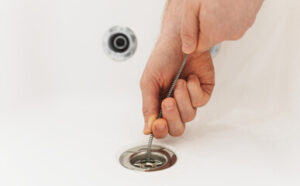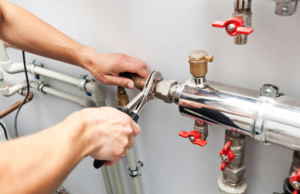Using the right drain cleaner can help keep your plumbing running smoothly. It can also remove foul odors from drains that may be caused by trapped hair, grease, soap scum, and paper.

Chemical drain cleaners are available at most retail stores and are composed of essential household substances like bleach, peroxides, and nitrates. These substances are heavier than water and sink through standing water to reach the clog. If you need professional help, contact Philadelphia Drain Cleaners.
Chemical drain cleaners are pure or mixed chemicals that dissolve at least some of the organic material clogging a drain. They come in liquid, gel, or powder form and are often found in hardware stores. Some chemical cleaners generate heat in a chemical reaction to help break down clogs; others use a combination of mechanical and chemical action to disperse hair, fats, oils, paper, and other debris from pipes. While they are effective at removing stubborn or deep-seated clogs, regular use of chemical drain cleaners can damage your plumbing system and emit harmful fumes.
If you must use chemical drain cleaners, follow the manufacturer’s instructions carefully to minimize safety risks. These products can irritate your nose, eyes, and throat, and may cause chemical burns if splashed on your skin. In addition, they can corrode metal pipes and weaken plastic PVC pipes over time.
Most chemical drain cleaners work by creating a chemical reaction with an acid, such as sulfuric or muriatic acid, to break down clogs. They can be toxic if ingested, and must be stored safely away from children and pets. The chemicals in these cleaners can also eat through the sides of your pipes, leaving holes that eventually leak or burst.
Oxidizing chemical drain cleaners are milder than acidic cleaners, but they can take longer to dissolve clog materials and may not be strong enough for severe blockages. Caustic cleaners, such as sodium hydroxide (lye), are very strong and can burn your skin and irritate your eyes. They generate a lot of heat in a chemical reaction and can melt or warp plastic pipes.
Enzymatic chemical drain cleaners are slowly gaining popularity because of their natural ingredients and effectiveness. Bacteria and enzymes in these cleaners break down clogs by chemically metabolizing them. These cleaners are more environmentally friendly than acid, caustic, and oxidizing cleaners, but they still require careful handling to avoid causing harm. Because they work slowly, enzymatic drain cleaners are best used as preventative maintenance, rather than a quick fix for blocked drains. Be sure to let your plumber know if you’ve used chemical drain cleaners before; they may need to use different tools or techniques to avoid damaging your pipes.
Oxidizing Drain Cleaners
Most chemical drain cleaners rely on powerful reactions to break up and disperse clog material. However, these chemicals are not good for your pipes or your health. They often release fumes that can irritate your nose, eyes and throat. Some even have the potential to burn your skin. And they’re definitely not good for your pipes or septic system, which can be damaged by these chemicals.
If your clog is caused by organic material such as hair, soap scum or food particles, an oxidizing drain cleaner may be the way to go. These cleaners usually contain peroxides, household bleach or nitrates, which generate gas and heat by stealing electrons from the material that’s causing your blockage. This process is similar to how hydrogen peroxide works when applied to a cut — it robs oxygen from bacteria to create an acid that breaks down tissue.
Other chemical drain cleaners use highly alkaline solutions with hydroxide ions to dissolve grease and other clog materials. These are typically effective for minor clogs but don’t work on stubborn ones. Some of these cleaners also have the potential to damage your pipes because they generate a lot of heat, which can melt or warp PVC plastic drain lines and cause metal ones to corrode.
Regardless of the type of chemical drain cleaner you choose, it’s important to follow the manufacturer’s instructions precisely. Most of these products require you to run hot water down the drain afterward to flush out any remaining clog material and wash away any residual cleaner. They also instruct you to wear rubber gloves, face masks and eye protection when using them.
For a safer alternative to commercial chemical drain cleaners, try pouring a cup of baking soda followed by a cup of vinegar down your drain. This creates a chemical reaction that can dissolve most types of clogs, including those caused by hair, soap scum and food particles. If these methods don’t work, it’s probably time to call in a plumber. They’ll be able to assess the severity of your clog and recommend the best course of action.
Enzymatic Drain Cleaners
Unlike chemical drain cleaners, which can cause severe burns and respiratory problems, enzyme drain cleaners are formulated without any harmful chemicals. Instead, they contain bacteria cultures and concentrated enzymes that feed on organic materials found in your pipes. These organisms digest and break down mildew, mold, hair, food waste, and other clog-causing substances. They then reproduce and spread “good” bacteria throughout your plumbing system that will continue to break down and eat away at organic materials even after the clog has been cleared.
Since enzymatic drain cleaners don’t use heat, pressure, or a chemical reaction to clear clogs, they are safe for most pipes. However, they are not as effective on tough clogs and may require more time to complete the job. In addition, if your clog is caused by something metal or plastic (such as a child’s toy) it will likely need to be removed with a physical drain cleaner like a plumber snake or hydro jetter.
While chemical-based drain cleaners can be effective, they also corrode your pipes and emit harmful fumes. On the other hand, enzyme-based drain cleaners are safe for your pipes and the environment. Additionally, they can be an effective alternative to chemical-based cleaners for maintaining a hygienic home.
Regardless of which type of drain cleaner you choose, it’s important to use them regularly to prevent clogs and blockages from forming. Aim to use them at least once a month, or whenever you notice that the drain is slowing down. For the best results, combine them with a regular cleaning schedule such as using baking soda and hot water once a week to keep your drains clean and free of residue buildup. This will help prevent future clogs and make it easier to remove stubborn ones when they do occur.
Natural Drain Cleaners
If you don’t want to risk damaging your pipes with caustic chemicals, there are natural drain cleaners that will dissolve and dislodge clogs without creating toxic fumes. One option is to combine non-toxic baking soda and vinegar. Simply pour 1/2 cup of baking soda down the clogged drain followed immediately by 1/2 cup of vinegar. Allow it to sit for about an hour, then flush with hot water. Repeat as necessary to fully unclog the drain.
Another natural choice is a biological drain cleaner, which contains live microorganisms that break down organic waste. These products are biodegradable, so they won’t damage your pipes or the environment. However, they may take longer than chemical drain cleaners to dissolve and dislodge clogs.
When choosing a biological drain cleaner, make sure it is labeled as “non-toxic” and has a high gradeability rating. Also, read reviews to see if the product worked for other people.
Besides using an enzyme drain cleaner, you can prevent future clogs by keeping your drain lines clean with a bacterial cleaner. These products introduce good bacteria into your plumbing system that digest organic waste and eliminate odors. These cleaners are safe for use in all types of pipes and won’t damage your pipes or the environment.
For stubborn clogs, try using a plunger or DIY drain snake. A reusable drain snake is made from a wire coat hanger that you bend into a hook shape and insert down your clogged pipe. Just be careful not to pinch your fingers while working with this homemade solution!
If neither of these remedies work, it’s time to call a professional. Be sure to tell the plumber if you’ve used any chemical drain cleaners. Also, be sure to tell them what caused the clog so they can recommend the proper solution.
Keep a bottle of natural drain cleaner on hand to tackle household clogs before they get out of control. With the simple combination of baking soda and vinegar, you can create a chemical reaction that will tackle most clogs. To avoid any spills, it’s best to pour the baking soda down first and then follow with the vinegar.



